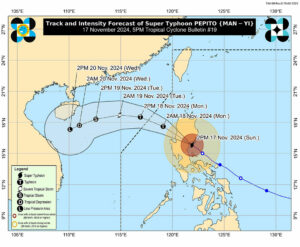Super Typhoon Man-Yi makes second landfall over Aurora province
THE state weather bureau on Sunday said that Super Typhoon Man-Yi, locally named Pepito, is expected to exit Luzon after making a second landfall over Aurora. In a 5 p.m. bulletin, the Philippine Atmospheric, Geophysical and Astronomical Services Administration (PAGASA) reported that Man-Yi made a second landfall in the vicinity of Dipaculao, Aurora at 3:20 […]

THE state weather bureau on Sunday said that Super Typhoon Man-Yi, locally named Pepito, is expected to exit Luzon after making a second landfall over Aurora.
In a 5 p.m. bulletin, the Philippine Atmospheric, Geophysical and Astronomical Services Administration (PAGASA) reported that Man-Yi made a second landfall in the vicinity of Dipaculao, Aurora at 3:20 p.m. It is forecast to exit the landmass of Luzon tonight or early Monday morning.
“During this period, Pepito will significantly weaken due to land interaction,” PAGASA noted.
As of 5 p.m., Man-Yi was last seen over Nagtipunan, Quirino, moving northwestward at 25 kilometers per hour (kph).
Man-Yi was packing maximum sustained winds of up to 185 kph near the center, and gustiness of up to 230 kph.
PAGASA has raised Tropical Wind Signal No. 5 over the central portion of Aurora, the southern portion of Quirino (Nagtipunan), and the southern portion of Nueva Vizcaya.
The rest of Aurora, the rest of Nueva Vizcaya, the rest of Quirino, the southern portion of Ifugao, Benguet, the southern portion of Ilocos Sur, La Union, the eastern portion of Pangasinan, and the northern portion of Nueva Ecija were placed under Signal No. 4.
Under Signal No. 3 are the southern portion of Isabela, the rest of Ifugao, Mountain Province, the southern portion of Kalinga, the southe000rn portion of Abra, the rest of Ilocos Sur, the rest of Pangasinan, the northern and eastern portions of Tarlac, the rest of Nueva Ecija, the northern portion of Bulacan, and the northern portion of Quezon including the rest of Polillo Islands.
The rest of Isabela, the southwestern portion of mainland Cagayan, the rest of Kalinga, the southern portion of Apayao, the rest of Abra, Ilocos Norte, Zambales, the rest of Tarlac, the northern portion of Bataan, Pampanga, the rest of Bulacan, Metro Manila, Rizal, the northeastern portion of Laguna, and the central portion of Quezon were all under Signal No. 2.
Signal No. 1 was hoisted over the rest of mainland Cagayan, the rest of Apayao, the rest of Bataan, Cavite, the rest of Laguna, Batangas, the rest of Quezon, the northern portion of Occidental Mindoro including Lubang Islands, the northern portion of Oriental Mindoro, Marinduque, Camarines Norte, and the northern portion of Camarines Sur.
The Presidential Communications Office also announced on Sunday that local chief executives may cancel classes and/or suspend government work.
Data from the National Disaster Risk Reduction and Management Council (NDRRMC) showed 238,982 families or 852,475 people had been affected by Super Typhoon Man-Yi, Typhoon Toraji (Nika), and Super Typhoon Usagi (Ofel).
NDRRMC said 24,421 families or 75,581 people had stayed in 566 evacuation centers.
It said a total of 7,838 damaged houses were reported in Cagayan Region, Ilocos Region, Central Luzon, and the Cordillera Administrative region, 437 of which were totally destroyed.
No deaths had been reported but NDRRMC said at least two people have been injured.
ECONOMIC COST
The Philippine government has been counting the economic costs of recent storms that have resulted in agriculture damage worth billions of peso, its economic planning agency said, as the country braced for Super Typhoon Man-Yi.
National Economic Development Authority (NEDA) Secretary Arsenio M. Balisacan said the government expects the agriculture sector to be among the hardest-hit sectors in the face of storms.
“Agriculture, in the third quarter, declined by 2.8%. For the whole year, it’s likely negative for agriculture. So that’s the immediate effect,” he told BusinessWorld on the sidelines of an event on Friday.
When asked to clarify whether the impacts of previous tropical cyclones had already been taken into account in growth projections for 2024, Mr. Balisacan said: “Well, part of it showed up in the third quarter already. But I would expect the fourth quarter will show also the effects.”
Before Man-Yi, the Philippines was hit by Tropical Storm Trami (Kristine), which left over P3 billion in agricultural damage based on latest estimates from the Department of Agriculture (DA).
DA estimated the volume of production losses at 160,107 metric tons (MT) in 11 regions, covering 72,329 hectares of land.
Due largely to the impacts of weather disturbances and reduced government spending, the Philippine economy grew by 5.2% in the third quarter, lower than the revised 6.4% growth in the second quarter and the government’s 5.7% forecast.
The agriculture sector saw a 2.8% decline year-on-year, which NEDA linked to the El Niño and seven typhoons including Trami that resulted in an estimated P15.8-billion agricultural damage.
The successive storms disrupted supply chains and delayed harvests, he noted.
A Nov. 6 report by the Philippine Statistics Agency showed agricultural production experienced the steepest decline in nearly four years.
Before Man-yi’s landfall, the agriculture province of Cagayan in northern Luzon posted an initial P1.4 billion damage in agriculture largely covering crops like rice, corn, coconut, and bananas after Typhoon Krathon (Julian), Trami, Super Typhoon Kong-rey (Leon), and Typhoon Yinxing (Marce) hit northern Philippines since the last week of September.
President Ferdinand R. Marcos, Jr. earlier this month said typhoons experienced by his country have been increasingly unpredictable due to the changing climate, and that his government doesn’t have a “template to follow” in terms of response.
“It is climate change, and it is the new reality that we are having to face,” he told reporters.
The President held a disaster briefing on Friday in anticipation of Man-Yi’s impacts.
On Sunday, the presidential palace said the Philippine leader had directed authorities to implement preemptive measures amid Man-Yi’s devastation.
Meanwhile, a political group on Sunday urged the government to use seized illegal online casino hubs as evacuation centers as Super Typhoon Man-Yi battered the country.
“We have numerous POGO (Philippine Offshore Gaming Operator) facilities in areas like Bamban, Porac, Bataan, Bulacan, and Cagayan that can serve as spacious, well-equipped evacuation centers,” Neri J. Colmenares, one of Bayan Muna party-list’s nominees in the midterm elections next year, said in a statement.
Philippine authorities earlier this year began cracking down on illegal online casinos due to crimes linked to it, such as human trafficking, financial scams, and torture. POGOs also raised national security concerns because of some hubs’ proximity to military facilities.
Mr. Colmenares said the POGO sites are spacious and already equipped with medical facilities, making them suitable disaster shelters. — Adrian H. Halili, Kyle Aristophere T. Atienza, and Kenneth Christiane L. Basilio













